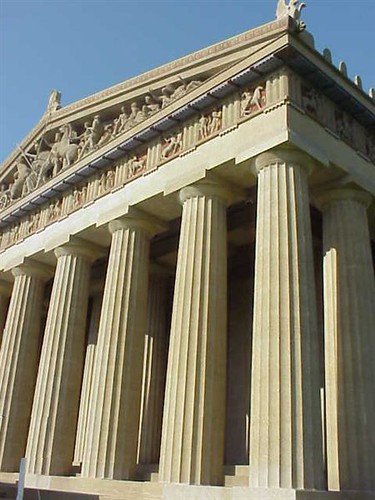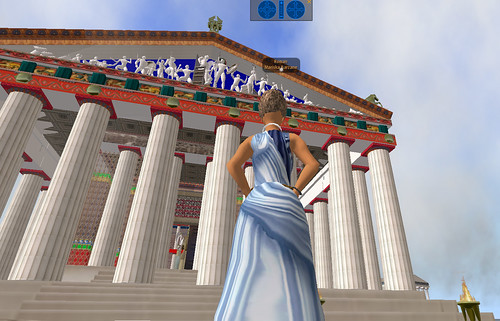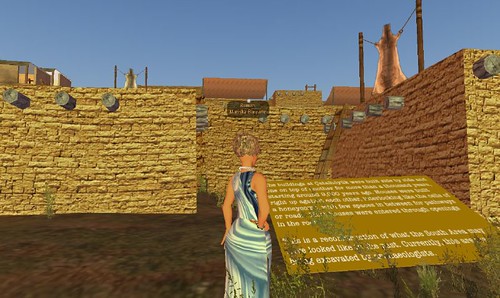 The cast and crew of Percy Jackson and the Olympians: The Lightning Thief didn’t have to go all the way to Athens to film the hydra scene in the Parthenon. They just booked some time in a reconstruction of the Parthenon in Nashville, Tennesse. Perhaps in the future, as the role of CGI increases in movies, they will be able to use a virtual version. I visited the Nashville Parthenon, as well as Second Life’s virtual reconstruction, to find out what the Parthenon of Athens was really like in the time of the ancient Greeks.
The cast and crew of Percy Jackson and the Olympians: The Lightning Thief didn’t have to go all the way to Athens to film the hydra scene in the Parthenon. They just booked some time in a reconstruction of the Parthenon in Nashville, Tennesse. Perhaps in the future, as the role of CGI increases in movies, they will be able to use a virtual version. I visited the Nashville Parthenon, as well as Second Life’s virtual reconstruction, to find out what the Parthenon of Athens was really like in the time of the ancient Greeks.
The Nashville Parthenon
I know, most people think of Nashville as home of the Grand Ole Opry and the country music capital of the world, but people there also have a taste for the classics! The Parthenon in Nashville is a full-scale replica of the original in Athens. It was built in 1897 as part of the Tennessee Centennial Exposition. Apparently, Nashville was once known as the “Athens of the South”, a title which influenced the construction of the replica for the fair.
The original replica was built of plaster, wood and brick but was replaced by concrete construction that began in 1920. The exterior was completed in 1925 and the interior was finally finished in 1931. In 1990, sculptor Alan LeQuire, a native of Nashville, recreated the 42-foot statue of Athena Parthenos to add to its interior. The statue of Athena is gilded with eight pounds of gold leaf.
 The structure, now the centerpiece of Centennial Park, houses an art museum that contains casts of the original Parthenon (Elgin) Marbles. In the summer, local theater troupes present classic Greek plays such as Euripides’ Medea and Sophocles’ Antigone. Most performances are free.
The structure, now the centerpiece of Centennial Park, houses an art museum that contains casts of the original Parthenon (Elgin) Marbles. In the summer, local theater troupes present classic Greek plays such as Euripides’ Medea and Sophocles’ Antigone. Most performances are free.
To view my entire tour of the Parthenon in Nashville, play the slideshow below. If you view the slideshow in full screen mode, you can click “Show Info” to view titles and descriptions to learn more.
The Parthenon in Second Life
If you can’t make it to either Athens or Nashville, you can find a recreation of the Parthenon and several other Greek landmarks in Second Life. You can even visit a virtual armour museum and climb aboard a Greek war galley!
The Second Life reconstruction I visited was created by Second Life user Noyle Boucher. As you can see by these images, the virtual Parthenon is brightly painted (as it was in ancient times!) and contains its own towering statue of Athena. Like the physical replica in Nashville, you can also climb steps to an observation gallery that brings you closer to Athena’s face and the statue of Nike (winged Victory) that she holds in the palm of her hand. I was also delighted to find that her shield includes sculptured scenes like those I had seen on the shield of the Athena Parthenos in Nashville.
 I also visited Boucher’s reconstruction of the Erechtheion. The temple, built between 421 and 407 BC, is thought to have been named for the shrine of the famous Greek hero Erichthonius but others think it was built in honor of the legendary king Erechtheus, who ruled Athens during the Archaic period and was mentioned in Homer’s Iliad.
I also visited Boucher’s reconstruction of the Erechtheion. The temple, built between 421 and 407 BC, is thought to have been named for the shrine of the famous Greek hero Erichthonius but others think it was built in honor of the legendary king Erechtheus, who ruled Athens during the Archaic period and was mentioned in Homer’s Iliad.
On the north side of the structure is the famous ‘Porch of the maidens’. Roman architect Vitruvius claimed the maidens on the porch of the Erchtheion, known as caryatids, represented women from the village of Kary, a town near Sparta in Laconia, who were condemned to slavery after betraying Athens by siding with Persia in the Greco-Persian Wars.
Scholars point out, however, that this is doubtful since supports depicting young women were used before the outbreak of the Greco-Persian Wars. Priestesses of Athena or Artemis used to carry sacred objects to feasts in baskets on their heads. Therefore, some scholars think these maidens represent such priestesses of Artemis in Kary. I managed to use the flying navigation control to position my avatar next to the virtual caryatids to get a great screenshot.
To view my entire Greek adventure in Second Life, play the slideshow below. If you view the slideshow in full screen mode, you can click “Show Info” to view titles and descriptions to learn more.
You can see the remains of temples on the Acropolis as they appear today in Google Earth, or take a visit to the real site. For more virtual reconstructions, check out Heritage Key’s virtual areas, including King Tut Virtual, and Stonehenge.





